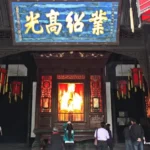Located in the heart of Chengdu, Jinsha Site Museum is a must-see destination for history lovers and curious travelers. This museum showcases the fascinating archaeological discoveries from the ancient Shu civilization, dating back over 3,000 years. Whether you’re interested in the famous gold mask, the intricate jade artifacts, or the site’s historical significance, this guide will provide all the information you need for your visit. In this comprehensive guide, we’ll show you how to visit Jinsha Site Museum with ease and give you tips on making the most of your time.
1. Introduction to Jinsha Site Museum
The Jinsha Site Museum is one of the most important archaeological museums in China. Discovered in 2001, the site revealed significant finds from the ancient Shu Kingdom, a civilization that flourished in the Sichuan region. The museum opened in 2007, and today it stands as a testament to the region’s ancient past. It contains over 6,000 artifacts, including bronze, gold, jade, and ivory relics. Visitors can explore various exhibits, as well as the actual archaeological site where the relics were uncovered.
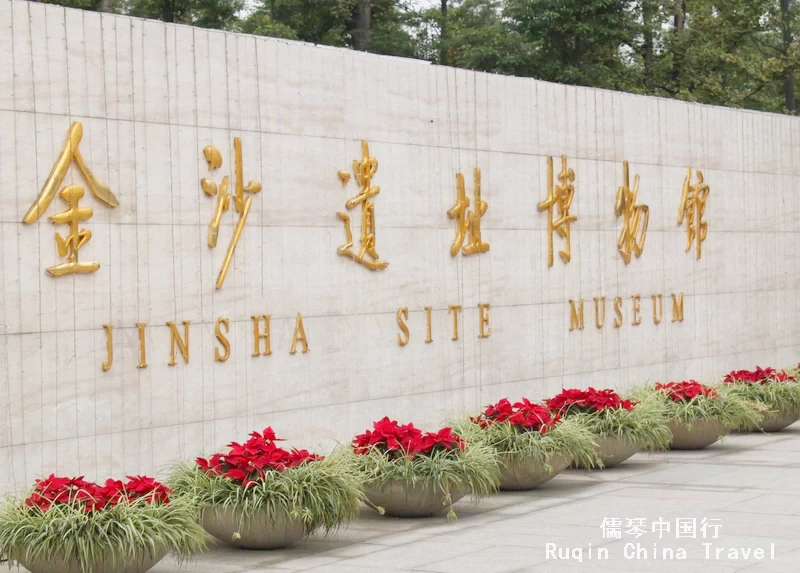
This museum offers a deep dive into Chinese civilization history, with its collections reflecting the rich cultural and religious life of the ancient Shu people. It’s an essential stop for anyone looking to better understand China’s cultural heritage.
2. How to Get to Jinsha Site Museum from Chengdu
Getting to the Jinsha Site Museum from Chengdu is relatively straightforward. The museum is conveniently located about 7 kilometers (4.3 miles) from the city center, making it an easy day trip for visitors.
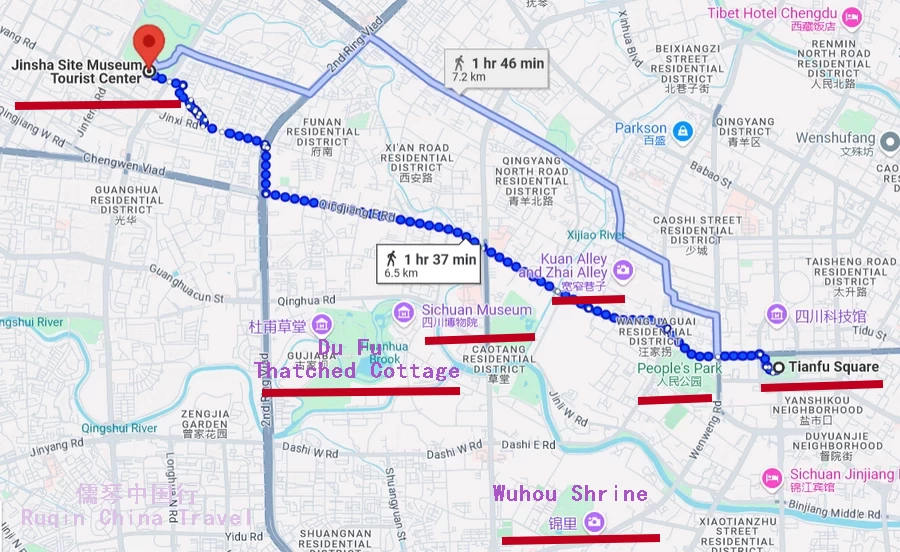
By Metro
The most convenient way to reach the museum is by taking Chengdu Metro Line 7. You should get off at Jinsha Site Museum Station, which is directly across from the museum entrance. The metro ride takes around 20-30 minutes, depending on where you’re starting in Chengdu.
By Bus
If you prefer to travel by bus, you can take Bus 7, 82, or 111. These buses stop near the museum, and the trip usually takes around 40 minutes, depending on traffic.
By Taxi or Ride-hailing Apps
Alternatively, you can take a taxi or use a ride-hailing service like Didi. The ride from downtown Chengdu to the Jinsha Site Museum will take about 20 minutes, depending on traffic conditions. This is the fastest and most convenient option if you’re short on time.
3. Best Time to Visit Jinsha Site Museum
The best time to visit Jinsha Site Museum is during Chengdu’s mild spring and autumn seasons, typically from March to May and September to November. During these months, the weather is pleasant, and the outdoor sections of the museum, including the archaeological site, are more enjoyable to explore. Summer can be quite hot and humid, while winter tends to be cold and damp.
Additionally, visiting the museum early in the morning or late in the afternoon is ideal to avoid crowds, especially during weekends or public holidays.
4. Entrance Fees and Opening Hours
Before planning your visit, it’s important to know the Jinsha Site Museum entrance fees and opening hours.
Service Line:028-87303522 | Address:No.2 Jinsha Site Road, Chengdu
Entrance Fee: The general admission fee is 70 RMB. Discounts are available for students, seniors, and children.
Booking: 1) Official Ticket Booking Site: Online Booking for Jinsha Site Musuem.
2) Book through Viator (great for English-speaking travelers):
👉 Jinsha Site Museum Tours and Tickets
Opening Hours: The museum is open daily from 8:00 AM to 6:00 PM, with the last admission at 5:00 PM.
Closed on Mondays except for January, Feburary, July, August, and statutory holidays.Allow at least two to three hours to fully explore the museum and its exhibits.
5. Things to Do at Jinsha Site Museum
There are plenty of things to do at Jinsha Site Museum to ensure a well-rounded experience. The museum is divided into several sections, each offering unique insights into the history and culture of the Shu civilization.
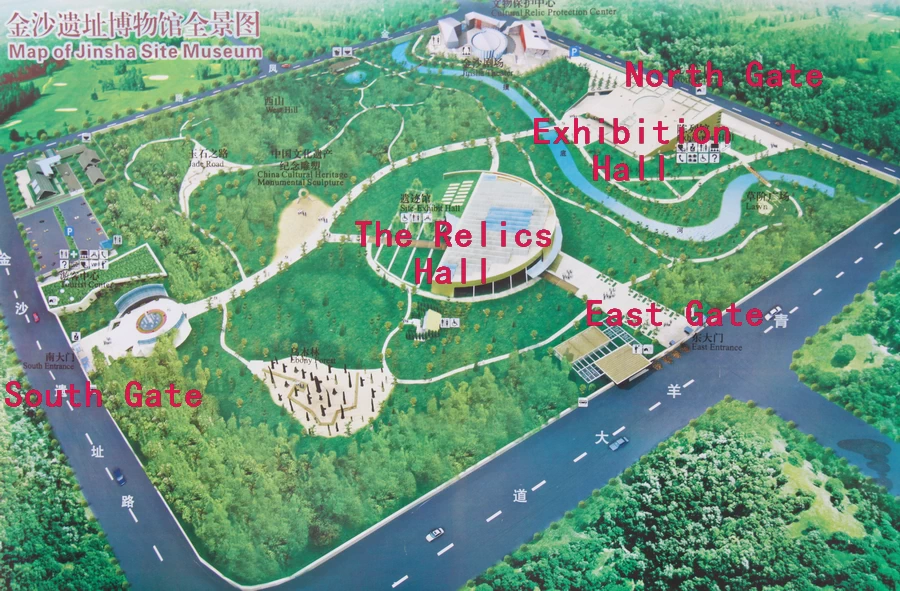
Visit the Relics Hall
The Relics Hall is where you can view the actual archaeological excavation site. This glass-covered area allows you to see where many of the important finds, including the gold mask and jade items, were discovered. It’s a fascinating glimpse into an ancient civilization and offers context to the items on display in the museum.
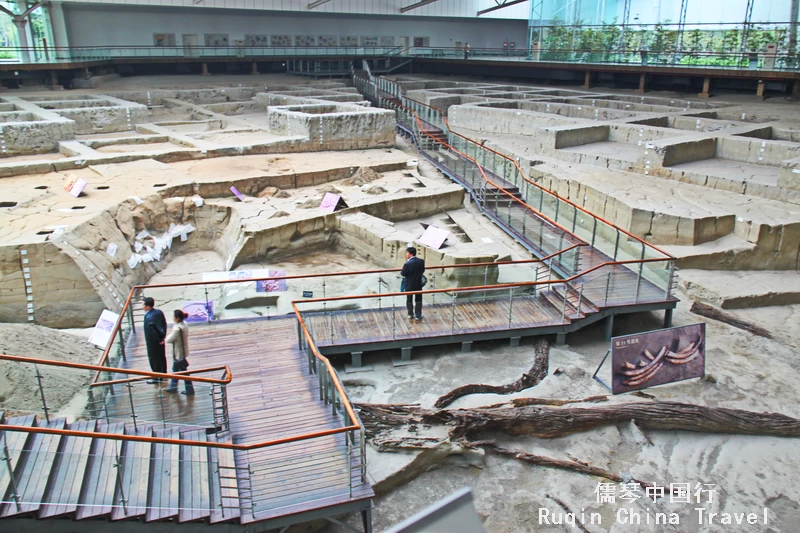
Explore the Exhibition Hall
In the Exhibition Hall, you’ll find thousands of artifacts, including the famous Jinsha gold mask, which is the most iconic piece in the collection. Other notable items include exquisite jade ornaments, intricately carved ivory, and bronze vessels. The displays are well-organized, with information in both Chinese and English, making it easy for foreign visitors to understand the history behind the objects.
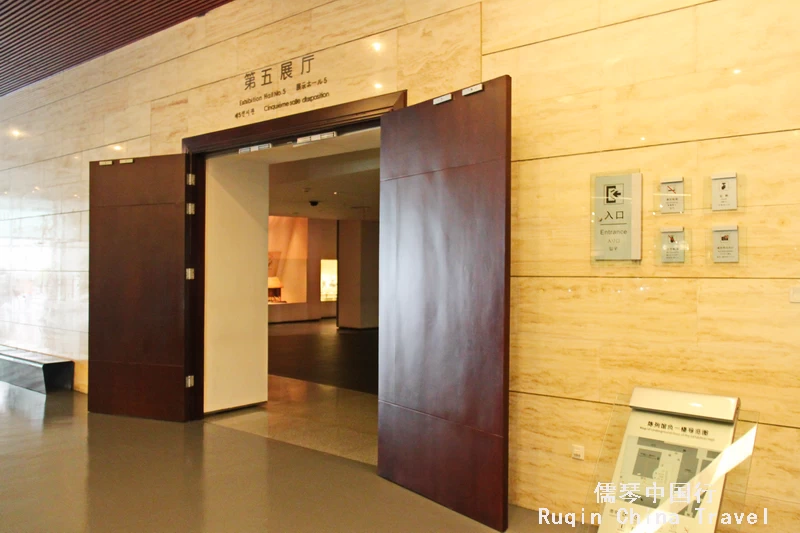
Stroll Through the Museum Gardens
After touring the indoor exhibits, take a relaxing stroll through the museum gardens. This outdoor area features statues, landscaped ponds, and pathways lined with trees, offering a peaceful setting to reflect on your visit.
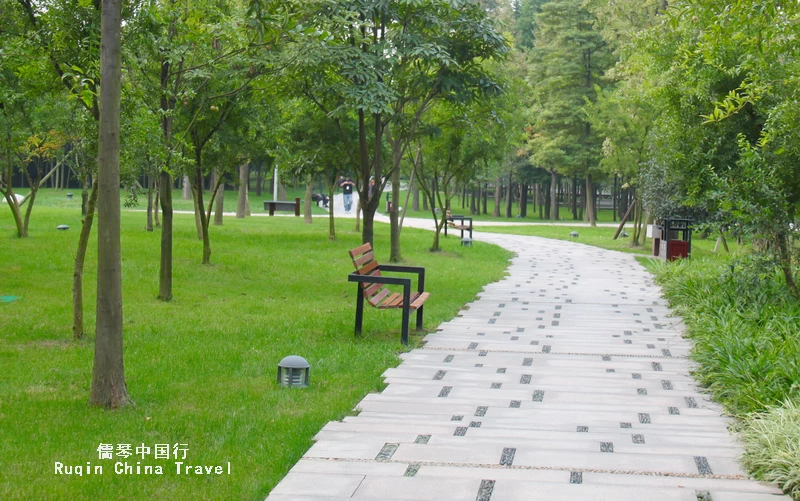
Attend a Cultural Performance
Occasionally, the museum hosts cultural performances that showcase traditional Shu music and dance. If you’re lucky, you may be able to catch one of these shows during your visit.
6. Top Attractions at Jinsha Site Museum
While the museum is full of fascinating exhibits, there are a few top attractions that you shouldn’t miss:
The Gold Mask: This stunning gold artifact is one of the most significant finds at the site. It’s thought to have been used in religious rituals, symbolizing power and spirituality.
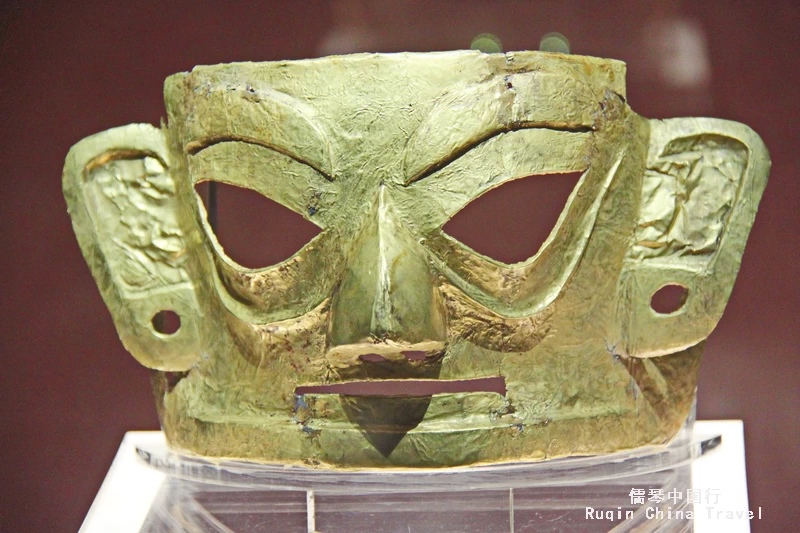
Sun and Immortal Birds Gold Ornament: Another must-see item, this delicate gold ornament is a masterpiece of ancient craftsmanship and has become a symbol of Chengdu’s cultural heritage.

Jade Exhibits at Jinsha Site Museum: The Jinsha Site Museum houses an impressive collection of jade artifacts, showcasing the intricate craftsmanship and cultural significance of jade in the Shu civilization. These ancient jade pieces, used in religious rituals and as symbols of power, provide insight into the beliefs and practices of this mysterious culture. Visitors can admire beautifully carved jade pendants, ceremonial objects, and other precious items, each reflecting the skill and artistry of the Shu people over 3,000 years ago. The jade exhibits are a highlight for those interested in ancient Chinese history and art.
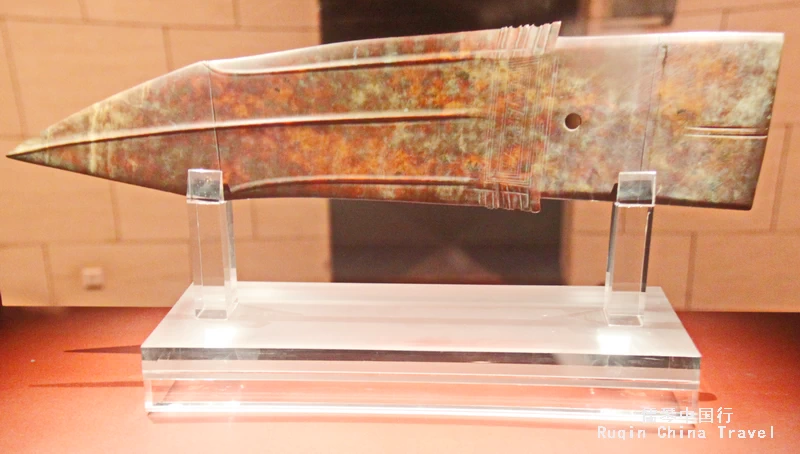
These must-see exhibits at Jinsha Site Museum provide a glimpse into the life, religion, and art of this ancient culture.
7. Jinsha Site Museum vs Sanxingdui Museum
When visiting Chengdu, many travelers wonder whether they should visit Jinsha Site Museum or the Sanxingdui Museum, another famous archaeological site nearby. While both museums display artifacts from the ancient Shu civilization, they highlight different periods and aspects of the culture.
Jinsha Site Museum focuses on the later Shu civilization, and its exhibits are more focused on religious and artistic artifacts, such as the gold mask and jade relics.
Sanxingdui Museum is located farther from Chengdu and displays items from an earlier period, known for its massive bronze statues and mysterious culture.
Both museums are highly recommended, but if you have limited time, Jinsha Site Museum is more convenient for a day trip from Chengdu.
8. Cultural Significance of Jinsha Site Museum
The cultural significance of Jinsha Site Museum cannot be overstated. The discoveries at the site provide crucial evidence about the Shu Kingdom, a mysterious and independent culture that flourished in the Sichuan Basin long before the Qin Dynasty unified China. The artifacts found here, especially the gold mask and Sun and Immortal Birds Ornament, reveal much about the religious beliefs, social structure, and artistic achievements of the Shu people.
Visiting the Jinsha Site Museum offers a rare chance to connect with a part of Chinese civilization history that remained hidden for centuries.
9. Jinsha Site Museum Guided Tours
For a more in-depth experience, consider joining one of the Jinsha Site Museum guided tours. These tours are available in both English and Chinese, and they offer deeper insights into the history and significance of the relics. A guided tour typically lasts about 90 minutes and is a great way to fully appreciate the museum’s rich collection.
Audio Guides
Visitors can rent audio guides in Chinese, English, Japanese, Korean, French, German, or Spanish. The cost is 20 or 40 yuan, depending on the language. You can pick them up at the South Gate Visitor Center, the East Entrance of the Relics Hall, or the first-floor lobby of the Exhibition Hall. For extra assistance, be sure to grab a guide brochure.
Guided Tours
A human-guided tour lasts around one hour. For foreign language tours, the cost is 70 yuan per person for groups of one to three people. If your group has four or more people, the price drops to 60 yuan per person.
Location: These services are offered at the South Gate Visitor Center and the East Gate ticket office.
Reservation Process: To book a tour, call 028-87303572 at least one day in advance.
10. Where to Stay Near Jinsha Site Museum
There are several accommodation options near Jinsha Site Museum for travelers who want to stay close by:
Holiday Inn Express Chengdu West Gate: A budget-friendly option located about 10 minutes from the museum by taxi. It offers comfortable rooms and easy access to public transportation.
Howard Johnson Hi-Tech Plaza Chengdu: A more upscale choice, this hotel provides luxurious accommodations and modern amenities. It’s about a 15-minute drive from the museum.
Chengdu Jinsha International Hotel: This mid-range option offers convenient access to both the museum and other major attractions in Chengdu.
For those planning a longer stay in Chengdu, staying near the museum provides easy access to both the museum and Chengdu’s other cultural sites.
11. Photography Spots
For photography enthusiasts, there are plenty of photography spots at Jinsha Site Museum. The Relics Hall offers excellent opportunities to capture the archaeological dig site, while the Exhibition Hall is perfect for close-up shots of the ancient artifacts.
Additionally, the museum gardens provide a scenic backdrop for photos, especially during the spring when flowers are in bloom.
Don’t forget to take pictures of the gold mask and the Sun and Immortal Birds Ornament, two of the most iconic relics in the collection.
12. Attractions Near Jinsha Site Museum
After exploring the Jinsha Site Museum, there are several nearby attractions worth visiting. Just a short distance away, you can find the Du Fu Thatched Cottage, a tranquil park and museum dedicated to the famous Tang Dynasty poet Du Fu.
Another popular spot is Qingyang Palace, one of the most significant Taoist temples in Chengdu, offering beautiful architecture and peaceful surroundings. For a more modern experience, head to Chengdu Museum, located in the city center, where you can explore exhibits on Sichuan’s rich history and culture. These attractions provide a well-rounded experience of Chengdu’s historical and cultural landscape.
13. Final Visitor Tips
Before wrapping up this Jinsha Site Museum travel guide, here are a few final tips to help you make the most of your visit:
- Arrive early to avoid crowds, especially during weekends and holidays.
- Bring water and snacks, as there are limited food options inside the museum.
- Wear comfortable shoes for walking around the large exhibition spaces and outdoor gardens.
- Respect museum rules: Photography is allowed in most areas, but be sure to check for signs where it may be prohibited.
Jinsha Dining Bar: The museum’s dining bar serves combo meals, tea, and coffee.
Location: Basement floor exit of the Exhibition Hall
Hours: 9:00 AM to 5:30 PM
Contact: 13540455819
By following these tips, you’ll ensure a smooth and enjoyable experience during your visit to Jinsha Site Museum.
Now that you know how to visit Jinsha Site Museum, you’re ready to explore one of Chengdu’s most fascinating archaeological sites. From the incredible gold mask to the serene museum gardens, this museum offers a unique glimpse into the ancient Shu civilization and its lasting impact on Chinese history.
More Chengdu Travel Guides
Plan your Chengdu Tour? Our “Chengdu Travel Guide“ section offers essential advice to help you navigate the city like a pro. Welcome to the Chengdu Travel Guide, your ultimate resource for exploring the vibrant heart of Sichuan Province. Known as the home of the giant pandas and the birthplace of spicy Sichuan cuisine, Chengdu is a city where ancient traditions meet modern life.


